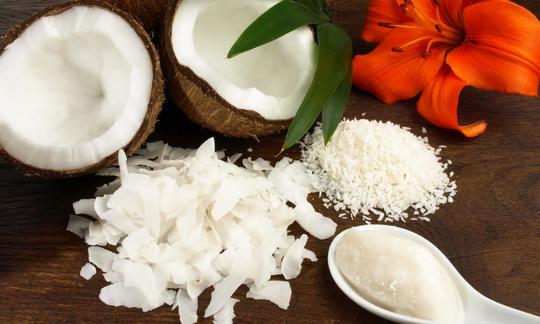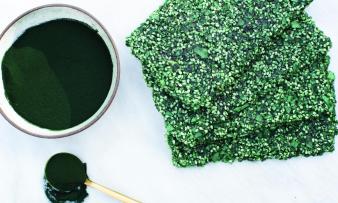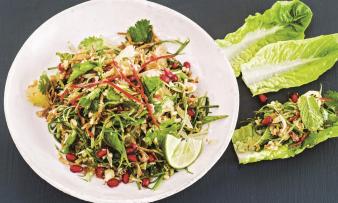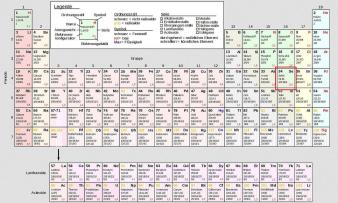Table of contents
Coconut flakes (organic?) consist of the dried and grated flesh of coconuts ( Cocos nucifera ).
Use in the kitchen
Coconut flakes have a sweet, nutty taste. They consist of finely grated, dried coconut meat . They are usually white to cream-colored. They are available both sweetened and unsweetened.
They are mainly used for cakes, pastries and sweet dishes or for garnishing cakes, delicious desserts and sweet dishes. They are also popular as a topping for muesli (for example for pea muesli ) or smoothie bowls . A few coconut flakes in fruit salad give it a light coconut flavor. They are also a great alternative to coconut chips . In Asia, they are mainly used as an ingredient in curries and stir-fries. They also taste good in soups or in breading, for example for sweet potato coconut nuggets .
Coconut milk can easily be made from desiccated coconut . For one liter of coconut milk, you need 200 g of desiccated coconut and 750 ml of water. Optionally, you can add a pinch of salt. Finely grind the desiccated coconut in a blender. Boil the water and add it to the ground desiccated coconut. Leave to steep for at least 10 minutes. Mix the mixture until it becomes a homogeneous liquid. Filter the mixture through a nut milk bag (muslin cloth), squeeze it well and collect the coconut milk. The coconut milk can be stored in a closed container in the refrigerator for three to four days. After a short time in the refrigerator, a creamy layer of coconut will settle in the upper part of the container. This can be used to make coconut cream . Before using the coconut milk, shake the closed container vigorously so that the fat in the coconut milk combines with the water.
Vegan recipe for pumpkin soup with desiccated coconut
Ingredients (for 4 people): 2 shallots , 1 clove of garlic , 1 tbsp rapeseed oil , 300 g butternut squash , 1/2 tsp curry powder , 2 tbsp coconut flakes, 6 dl vegetable stock .
Preparation: Cut the butternut squash into pieces of about 2 cm. Chop the shallots and garlic clove and sauté in a pan with rapeseed oil. Add the pumpkin and sauté. Add the curry powder and coconut flakes. Deglaze with vegetable stock and cook for 30 minutes. Puree with a hand blender to make a soup, diluting with water if necessary.
Vegan recipes with coconut flakes can be found under the note: " Recipes that have the most of this ingredient ".
| Not only vegans or vegetarians should read this: Vegans often eat unhealthily. Avoidable nutritional mistakes . |
Purchasing - Storage
Large retailers such as Coop , Migros , Rewe , Edeka , Hofer , Volg , Spar , Aldi , Lidl and Billa usually have coconut flakes in their range. Sometimes they are also organic. Organic supermarkets such as Denn's Biomarkt and Alnatura also have coconut flakes. They can also be found in Asian shops or online shops. If you value raw food quality, you should look for products that are labelled as such.
The availability of coconut flakes varies depending on the size of the store, catchment area, etc. If you are interested, click on our recorded food prices for the DA-CH countries (above under the ingredient image). There you will find current prices from various supermarkets and their price development.
Storage tips:
Coconut flakes should be stored in an airtight container, dry and protected from heat. Unopened, they will last up to two years and opened, about a year.
Ingredients - Nutritional values - Calories
Coconut flakes (organic) contain 660 kcal per 100 g. They have a high fat content of 65 g/100g. This corresponds to 92.2% of the recommended maximum daily intake of fat. They are rich in fiber (16 g/100g). The 24 g of carbohydrates per 100 g correspond to 8.8% of the daily requirement. The protein content is 6.9 g, which corresponds to 13.8% of the daily protein requirement. 1
At 2.7 mg/100 g, they contain a significant amount of manganese . This corresponds to 137% of the daily requirement. Coconut chips have a similar content (2.1 mg/100 g). Quinoa and amaranth contain comparable amounts of manganese (2.0 mg and 2.3 mg/100 respectively), but have much less fat than coconut flakes. 1
Do coconut flakes contain selenium? Coconut flakes contain a large amount of selenium, at 18 µg/100g. This corresponds to 34.0% of the daily requirement. Brazil nuts are particularly rich in selenium. Just 1-3 Brazil nuts (from Bolivia) cover the daily requirement of selenium. 1
It also contains large amounts of copper , phosphorus , potassium , iron and magnesium . 1 Since coconut flakes should only be eaten in small quantities due to their high fat content, the actual nutrient content absorbed is put into perspective.
You can find the complete ingredients of coconut flakes, the coverage of the daily requirement and comparison values with other ingredients in our nutrient tables. In the article Nutrients explained you will get a detailed insight into the topic.
Effects on health
Can I lose weight with coconut flakes? Due to the high proportion of medium-chain fatty acids (MCT), you often read that you can lose weight with coconut products. This goes back to a study by nutritionist Marie-Pierre St-Onge , who showed that medium-chain triglycerides (MCT) can help adults lose weight. 6,7,8 However, a special coconut oil was produced for this purpose that was made up of 100% of these fatty acids. Commercially available coconut oil only contains 13-14% of these medium-chain triglycerides. 7 The German Nutrition Society ( DGE ) has revoked this test and trend because more recent studies have found no effect on thermogenesis or fat burning. 5
Are coconut flakes healthy? Coconut products such as coconut flakes consist practically only of fat. Intensive or long-term consumption in large quantities leads to long-term and sometimes life-threatening negative consequences. If you generally eat healthily and occasionally allow yourself small amounts of coconut as a special treat, this is not a problem, even if we do not recommend it.
For more information on health aspects, see the link to coconut oil (coconut oil, coconut fat) .
Dangers - Intolerances - Side effects
Coconuts and coconut products such as coconut flakes have been advertised as 'superfoods' for years. However, this is purely an industry interest in increasing sales. Vegans in particular use coconut milk as a milk or cream substitute, the oil for cooking and baking or for the skin, etc. According to interested circles, coconut blossom sugar is also said to have many advantages over conventional beet sugar.
The coconut boom is a big mistake, however, because the composition of the fatty acids in the oil is particularly unhealthy: Coconut oil consists of around 82% saturated fatty acids. At around 50%, even palm oil is healthier! Unsaturated fatty acids are also present, but the ratio of omega-6 to omega-3 fatty acids is significantly higher than the recommended maximum of 5:1 ( linoleic acid, LA , to alpha-linolenic acid, ALA ).
Are coconut flakes unhealthy? Eating coconut products increases the undesirable LDL cholesterol in the blood, which promotes cardiovascular disease. However, the healthy HDL increases slightly more, which then improves the total cholesterol level. Measured only by this ratio, coconut seems particularly healthy, which is a fallacy. In general, saturated fatty acids have a negative effect on blood values and cholesterol levels. A 2016 study analyzed 21 research papers, including 8 clinical studies and 13 observational studies, and concluded that replacing coconut oil with a healthier oil reduces the risk of cardiovascular disease. 4 We recommend using rapeseed oil as a substitute or replacing oil consumption with nuts and seeds if possible.
A coconut allergy is rare. However, as consumption becomes more widespread, more and more cases of allergic reactions are being reported. This particularly affects children who are given coconut milk as a cow's milk substitute or who use coconut oil as a body lotion. It has been found that cross-allergies with walnuts , sesame , macadamia nuts , almonds and cashews can occur. 13,14
Ecological footprint - animal welfare
The ecological CO 2 footprint of desiccated coconut depends on various factors, including the way the coconuts are grown, processing, transport and packaging. Despite extensive research, we were unable to find any precise figures for the ecological footprint of desiccated coconut. According to the Big Climate Database, this is 3.5 kg CO 2 eq/kg for coconut milk 15 and 2.3 kg CO 2 eq/kg for coconut oil. 16 It can be assumed that the footprint for desiccated coconut is quite similar.
Due to their numerous useful properties and clever marketing, coconuts are in demand almost worldwide - as food, but also for generating energy or for making decorations, furniture or medicine. In the tropical growing countries, this creates important jobs; in the Philippines, for example, up to 3.5 million people are directly or indirectly dependent on the coconut industry. 17 However, the coconut industry should be viewed with extreme skepticism, because small farmers often manage the coconut plantations for the western market, but the price is dictated by large trading companies. The farmers can barely live on this pay. When day laborers manage company-owned plantations, the conditions there are usually inhumane. 11 Certified goods have been available for years, but have rarely been in demand. 10 It should also be remembered that coconuts have had to travel long distances for our consumption and are therefore associated with high emissions.
The area required to grow coconut palms is often associated with land theft, deforestation and the destruction of local biodiversity. In order to meet the high demand, mixed crops are rarely planted, but monocultures are preferred. Coconut oil is also increasingly replacing the controversial palm oil . However, the yield of oil palms, with an average of around 3.8 tons of oil per hectare, is far higher than that of coconut oil, with 0.7 tons of oil per hectare. 11 If you look at the number of endangered species per million tons of oil produced, coconut oil performs even worse than palm oil. 18
A study by the University of Exeter shows that an average of 60 species on the IUCN Red List are threatened as a result. 10 Since trained monkeys are sometimes used to harvest coconuts, consumption also leads to a lot of animal suffering. The monkeys are trained violently for several years until they are able to pick the coconuts from the tall palm trees, which they have to do while tied up until they die. 9
Worldwide occurrence - cultivation
Coconut palms grow mainly in the equatorial zone, i.e. in tropical areas. People have been using the coconut palm for at least 3000 years. It probably originated in Polynesia (Pacific island region). From the 19th century onwards, coconuts gained economic importance when they were cultivated on plantations by the Dutch in Ceylon. 3
According to FAOSTAT , around 63.6 million tons of coconuts were produced worldwide in 2021. The main growing areas are Indonesia (17.1 million tons), Philippines (14.7 million tons), India (14.3 million tons), Sri Lanka (2.4 million tons). 2
For information on growing and harvesting coconuts, see Coconut meat, raw (Coconut meat, organic?)
Industrial production
To make coconut flakes, the coconuts are peeled and then the brown skin (testa) is removed. The peeled kernels with the flesh are cut open and the coconut water is removed. The flesh is then washed to remove coconut water and other deposits and to prevent discoloration. The coconut flesh is then pasteurized in steam for at least 5 minutes at around 88 °C or 8 to 10 minutes at 70 to 80 °C. It is then immersed in a sulfite solution to stabilize it. The flesh is then chopped or ground to the desired size and dried until it contains a moisture content of just 2.5–3.0%. The coconut flakes are then cooled and packaged for sale. 12
Further information
The coconut palm ( Cocos nucifera ) is the only species of this genus, but there are many different varieties. The coconut is not a nut, but a single-seeded drupe. It consists of three carpels that grow together, which is why it is often slightly triangular in shape. The three eyes that you see on one side are the three germ holes, whereby only one germ begins to grow at a time.
Are coconut flakes and coconut shavings the same thing? Coconut shavings are fine flakes made from dried coconut flesh . Coconut chips are fine, thin strips of coconut flesh that are gently dried or baked. These should not be confused with coconut flour , which is made from the pomace (pressed pulp) that remains from the production of coconut milk , coconut cream or coconut oil .
Alternative names
In English, the fruit, the tree or the seed are called coconut or cocoanut. When referring to the palm tree, one speaks of the coconut tree. In English, coconut flakes are called coconut flakes, grated coconut, shredded coconut or desiccated coconut.











Comments